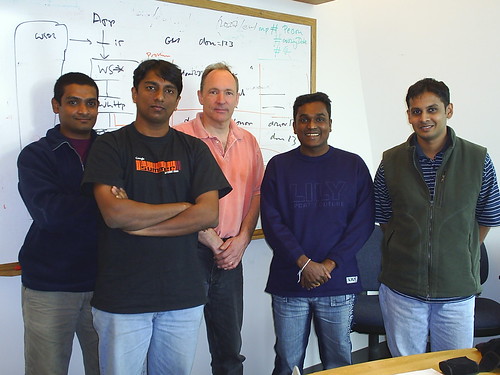The W3C have issued a very odd document "
Relationship between Mobile Web Best Practices (MWBP) and Web Content Accessibility Guidelines (WCAG)", which which brings new meaning to the term "
nothing". It is not so much about the relationship between WCAG and MWBP, but the failure of the W3C to produce one. This document is the
technical equivalent of Beckett's play:
Waiting for Godot.
The working draft of 3 July 2008 tries to explain the relationships, overlaps and differences between the
Web Content Accessibility Guidelines (
WCAG) and the
Mobile Web Best Practices (
MWBP). But it seems to be a by-product of rivalry between W3C working groups, which will be largely unintelligible to outsiders.
The WCAG were primarily intended to make web pages accessible to people with disabilities (such as the blind). But they also had mobile devices in mind, taking into account small screens, slow Internet connections, limited keyboards and pointing devices. I have been
teaching the use of the accessibility guidelines for mobile devices to students since 2001.
The
Mobile Web Best Practices (
MWBP) are the latest of many attempts to get web pages on mobile phones. Previous attempts failed, largely due to the extreme limitations of mobile devices and partly due to the mobile phone industry's different business models. Mobile devices now have bigger screens and more advanced web browsers, so making web pages is easier. But the MWBP's work is still needed to help designers take account of mobile limitations.
This relationship document is very strangely worded. It is not so much a technical report, as a political one. It
asks the reader to first read
Web Content Accessibility and Mobile Web: Making a Web Site Accessible Both for People with Disabilities and for Mobile Devices and
Experiences Shared by People with Disabilities and by People Using Mobile Devices. Then it asks the reader to either read
MWBP to WCAG 2.0 or
MWBP to WCAG 1.0 and
WCAG 2.0 to MWBP or
WCAG 1.0 to MWBP. There is the a table which apparently tries to make this clear:
If that is not enough for the reader, it then
refers them to the to the
Web Content Accessibility Guidelines and
Mobile Web Best Practices. Then referring to yet another document: "
Experiences Shared by People with Disabilities and by People Using Mobile Devices [Editors' Draft, January 2008]".
At
this point the document finally gets around to telling the reader something useful about the topic:
"The Mobile Web Best Practices (BP) are not assigned levels. MWBP relates to checkpoints of all the WCAG 1.0 priorities (1, 2 and 3) and to all the WCAG 2.0 level A, AA and AAA success criteria."
However, we are now almost at the end of the document. So far there has been only
one sentence containing useful information on the topic.
What then follows is a paragraph explaining why there is
no mapping table detailing differences between WCAG and MWBP, and so attempting to explain why this technical report fails in what it set out to do. Then there is an appendix attempting to redefine common English words to be "
Special Terms":
everything, nothing, partially, possibly, and
something. The document then ends.
This reminds me of many public service ICT documents written by people who did not want to do something and who used a lot of words to obscure the fact that they had not done it. W3C should decide if they genuinely want to relate Mobile Web and Web Accessibility (which would be a good idea), or if it is too hard to do. If it is too hard, then this document should be rewritten to honestly say that, rather than trying to obscure the fact that two of the working groups do not want to cooperate.
As it is, the document "
Relationship between Mobile Web Best Practices (MWBP) and Web Content Accessibility Guidelines (WCAG)", is like Beckett's play
Waiting for Godot, where the characters wait for someone named Godot, who never arrives. In the case of the W3C's report we wait for a relationship which never arrives.
Labels: accessibility, mobile web, Standards, w3c


